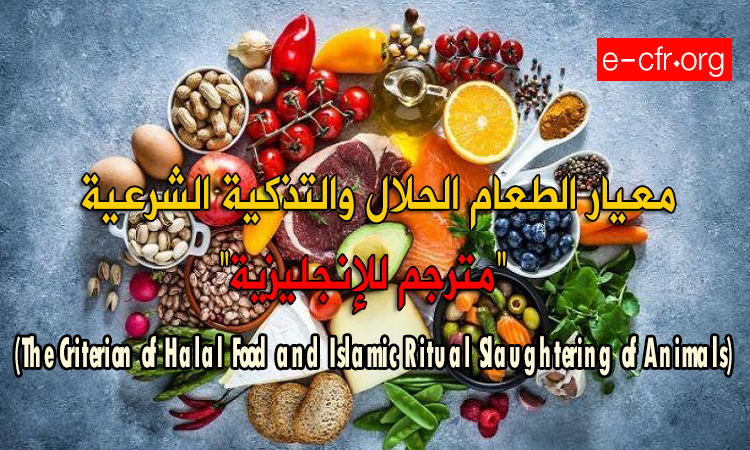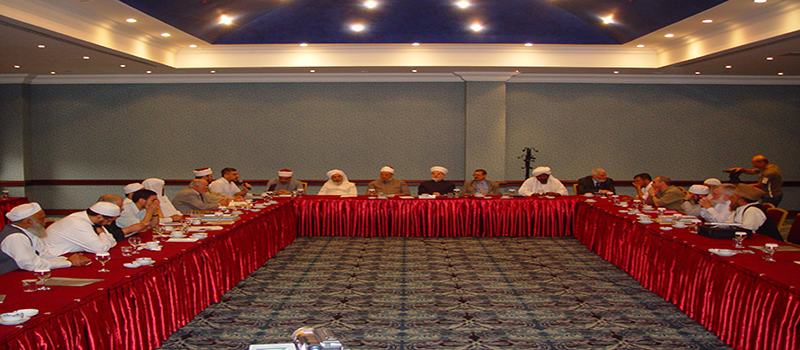The Criterion of Halal Food and Islamic Ritual Slaughtering of Animals

The Criterion of Halal Food and Islamic Ritual Slaughtering of Animals
(In the Light of the Remarks Made by the Members of the Committee Commissioned to Prepare the Project of the Criterion)
Dr. Abdussattar Abu Ghiddah
Chairman of the Committee
The European Council for Fatwa and Research
Setting of the criterion
:Table of Contents
Definition of the Halal food
The permissible and impermissible animals and plants
The methods of ritual slaughtering
The prerequisites of ritual slaughtering (Appendix on stunning leading to unconsciousness)
Abattoirs and places of storage
Etiquettes of ritual slaughtering
Elucidating the Halal requirements
Health, cleanliness and purity
Authentication and the pertinent laws
Definition of the Halal food
The Halal food refers to the animals and plants permissible to consume prepared in consistency with the below-stated conditions and prerequisites, the foremost of which is that they do not contain any item classified as impermissible by Shari’ah, that when preparing for them for consumption none of the tools or the procedures prohibited by Shari’ah is applied, and that they should meet all the health requirements.
The animals and plants permissible and impermissible to consume
It is permissible to consume animals ritually slaughtered according to Islam as well as non-harmful plants provided that none of the items prohibited by Islam is added or applied when cooking.
It is impermissible to consume the carrion (and their likes as will be elucidated) and blood, and the flesh of the swine, and whatsoever has been slaughtered in the name of some other than Allah
- It is impermissible to consume the likes of the carrion, whatever has been strangled, or slaughtered by a blow or a fall, or by goring, or that which has been mauled by wild beasts unless slaughtered while still alive. Nevertheless, in the case of saving one’s life the above-mentioned prohibited categories could be consumed within the parameters of saving one’s life.
- Regardless of their names, all intoxicants, drugs and poisonous materials causing affirmed harm, are prohibited.
- The consumption of certain animals is prohibited according to the majority of the Muslim scholars, whereas some Muslim scholars classify it as disliked. Included in this category are dogs, snakes, animals that attack with their fangs among predatory animals, such as lions, wolves, dogs, cats, bears, monkeys, elephants and also birds that attack with their claws, and also harmful insects such as scorpions, and filthy creatures such as worms, and also animals that live on land and in water such as frogs, donkeys, and horses and also poisonous aquatic animals and poisonous plants as long as their poison is not removed.
- Regardless of their name, skin and shape, sea foods are permissible to consume provided that normally they live in water and are not poisonous nor predatory.
Ritual Slaughtering of Animals
- It is permissible to consume animals ritually slaughtered in one of the following methods:
- Thabh: It refers to the process of slaughtering animals by cutting the wind pipe, jugular veins and carotid arteries. This is the primary method of slaughtering animals especially cattle, sheep, and birds. It is permissible to apply this method to ritually slaughter other categories.
- Nahr, which involves stabbing the pit i.e. central front bottom part of the neck, is the Islamically preferred method of slaughtering camels and similar animals. It is permissible for cattle.
- Aqr involves causing wound in any part of the body of the animal, which is not under control, be it wild or tamed, but permissible to consume. However, if it is controlled alive then it should be subjected to Thabh or Nahr.
- As-Said: It refers to using trained dogs and birds to hunt animals. However, if it is controlled alive then it should be subjected to Thabh or Nahr. If the trained dog or bird eats part of the hunted animals, they become impermissible for Muslims to consume.
The Conditions the Butcher Should Meet
He should be sane, adult or a senior child Muslim, Christian or Jewish.
- He should be aware of the ritual slaughtering of animals and bearing in mind the official technical requirements. Courses should be provided to those who need them.
- Throughout all its phases the ritual slaughtering of animals should be supervised by honest observers and the label certifying the fulfilment of all the requirements for the official license for slaughtering animals should be displayed.
- There should be enough members of staff available for slaughtering animals to avoid complacency, hastiness and shortcomings.
- Primarily slaughtering animals is to be executed manually but there is no harm if equipment are applied to slaughter chicken ritually provided that the conditions of ritual slaughtering are met. In such a case the utterance of Tasmiyah (Bismillah) once for every group of chickens slaughtered continuously is sufficient. But if the process of the ritual slaughtering is interrupted the utterance of Tasmiyah is to be made again.
The Prerequisites of Ritual Slaughtering of the Animals
- The animals should be permissible to consume (Categories of animals are afore-mentioned).
- Animals should be alive before slaughtering.
- Animals should not be anesthetised and their consciousness should not be reduced to the extent that they die before being ritually slaughtered. (See detailed appendix on stunning animals).
- A sharp implement made of iron or any other type of metal, should be used, with a blade that cuts easily and drains blood.
- It should be ensured that the wind pipe, jugular veins have been cut and it is preferable not to cut the bone marrow.
- Tasmiyah (Bimillah) should be recited. However, if this is forgotten, the ritual slaughtering is valid. The Tasmiyah is not indispensable if animals are slaughtered by a Christian or a Jew.
Requirements for Abattoirs and Places of Storage
- When available, ritual slaughtering and storage of halal meat should be in places prepared for this purpose and if not then separation or cleaning should be made in a way that prevents the mixture of halal and non-halal foods.
- Official license and Islamic license must be obtained from a recognized organization
- The Islamic requirements of ritual slaughtering of the animals in all the phases should be available in writing in abattoirs
- Executing the ritual slaughtering of animals should be verified. Separation and cleaning should be ensured to prevent mixing halal and non-halal foods. Butchers executing ritual slaughtering should be identified and their proficiency should be verified to avoid any shortcomings.
Etiquettes for Ritual Slaughtering of Animals
- Animals prepared for ritual slaughtering should be treated gently and should not be ill-treated by the application of electric wires when delivered or slaughtered. This is to be observed in lairages where animals are collected and fed. The animals should not be fed animal protein or animal farina or chemical materials.
- The animals should be made comfortable and should be watered prior to ritual slaughtering.
- Implements should not be sharpened within the sight of the animals prepared for ritual slaughtering.
- Animals should not be slaughtered within the sight of animals prepared for slaughtering if at all possible.
- The animals should not be tortured and their parts hould not be cut even if it is meant to have them under control. The animals should not be skinned or sunk in hot water and their feathers should not be removed unless the departure of their souls is confirmed.
Securing the halal requirements
- The fundamental requirements of ritual slaughtering should be ascertained including:
- The utterance of the Tasmiyah (Bimillah) and playing a cassette is not sufficient.
- Frequent inspections to make sure that the requirements of ritual slaughtering are observed.
- All staff should be properly trained in the requirements of spiritual slaughter
- The organizations concerned with ritual slaughtering should have a system and programmes of verification.
- There should be unannounced to ensure that the right procedures are in effect.
- The organizations issuing halal certificates should have a system that includes the requirements of ritual slaughtering.
Health and Hygiene
In addition to the requirements of ritual slaughtering the following is to be observed:
- Animals’ health
- The cleanliness of the members of staff and abattoirs and facilitating sufficient laundries.
- Making sure that implements are not contaminated and washing them regularly and when needed.
- Applying special implements for ritual slaughtering and preparing halal food and if not viable then implements should be cleaned carefully prior to being used.
- The ritually slaughtered animals should be separated from other animals if they cannot be stored in a different place.
- The ritually slaughtered animals should be labelled stating the name of abattoir, registration number, date of slaughter and the number of the slaughtered group.
- A venetian should be in attendance to ensure that animals are alive before slaughtering and their meat is fir for consumption.
Verification and Legislation
- The registrations of the Halal products should be kept safe
- A daily report must be prepared and signed by the butchers to be checked when visited by the relevant organizations.
- The European Union regulations concerning the preparation, storage and transferring foods must be observed
- Relevant documents must be safely stored ready for check if needed.
Appendix
Reducing Animals’ Consciousness Prior to Ritual Slaughtering[1]
Primarily the ritual slaughtering does not involve reducing animals’ consciousness, since the Islamic method of slaughtering animals is the most ideal method in terms of clemency of animals, minimizing their suffering and properly slaughtering them. The companies in charge of slaughtering animals are required to improve their means of slaughtering large animals in a way that guarantees the best accomplishment of the afore-mentioned argument.
Bearing in mind the above-mentioned argument, the animals, whose consciousness is reduced, if ritually slaughtered are halal provided that technical requirements confirming that the animals are alive prior to slaughtering them ritually are fulfilled. Experts state that currently these requirements are as follows:
- When stunning animals the head-to-back system or jaw-to jaw should be applied.
- Applied voltages should be between 100 – 400 volts.
- Applied currents should between 0.75 – 1.0 HZ for sheep and between 2.0 – 2.5 HZ for cattle.
- The application of the current should be for a period between 3 – 6 seconds.
- It is not permissible to apply penetrating bolt devices e.g. pistols, axes or hammers as well as compressing air to make animals unconscious before applying ritual slaughtering.
- It is not permissible to apply electrical shocks to poultry prior to the application of ritual slaughtering since it has been practically proved that an unlimited percentage of them dies before being slaughtered.
- The animals, whose consciousness is reduced via application of non-penetrating pistols or a mixture of air and carbon dioxide or oxygen and carbon dioxide, are halal if ritually slaughtered while alive.
Muslims living in non-Muslim countries should apply legal means to obtain license to practice Islamic ritual slaughtering that does not involve reducing animals’ consciousness in advance and should defend their right to halal food.
N.B. Any further issues not covered in this document should be brought to the attention of the European Council for Fatwa and Research.
[1] Based on resolution No. 95 (03/10) issued by the International Fiqh Academy





